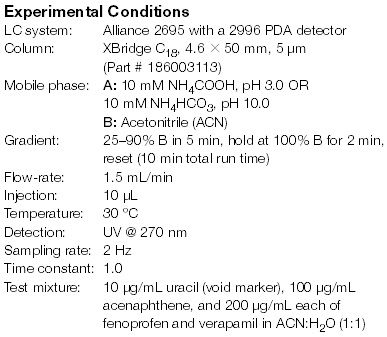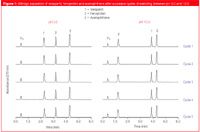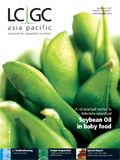Routine Switching between High and Low pH on Xbridge HPLC Columns
LCGC Asia Pacific
The effect of switching between high and low pH mobile phases on a single analytical HPLC column was investigated. The ability to rapidly switch between pH extremes on XBridge columns without special washing/re-equilibration steps dramatically reduces the time for separation of pharmaceutical compounds.
Kenneth J. Fountain, Damian Morrison, Diane M. Diehl and John Martin, Waters Corporation, Milford, Massachusetts, USA.
Introduction
The time required for drug screening, method development and compound purification using chromatographic methods is a key factor in meeting the demands of the pharmaceutical industry. It is desirable to have technology that is robust and stable under many different operating conditions to maximize HPLC method development efficiency. XBridge columns have the flexibility to operate under a variety of mobile phase and pH conditions without deterioration in performance over several hundred hours of operation.
XBridge columns are the second generation of hybrid particle technology first introduced by Waters in 1999. They offer improved chromatographic lifetime in both low and high pH conditions while still maintaining the efficiencies associated with traditional silica-based HPLC columns. This makes XBridge suitable for fast drug screening and purification of pharmaceutical compounds.
The current work investigates the use of a single XBridge column at both low and high pH for the separation of acidic, basic and neutral compounds. The mobile phase pH was varied at specific intervals to evaluate its effect on column performance. To date, few commercially available columns have the ability to switch between high and low pH without severe loss in chromatographic performance. Having the ability to switch between pH extremes on a single HPLC column can reduce instrument downtime by at least 50%, and allows for a broader range of operating conditions.

pH Switching Procedure
The column was first equilibrated at pH 3.0 for 10 min, followed by 20 injections of the test mixture. The column was then equilibrated at pH 10.0 for 10 min, followed by another 20 injections of the standard mixture. This cycle was repeated four more times (100 injections total at each pH).

Figure 1
Results and Discussion
Figure 1 demonstrates the separation performance of the XBridge C18 column after five cycles of switching between pH 3.0 and pH 10.0. It is clear that exposure to pH extremes does not compromise chromatographic performance on XBridge in subsequent pH cycles. In addition, reproducibility of the separation at each pH is exceptional (Table 1). These experiments clearly demonstrate the ability of XBridge columns to operate at high and low pH without loss of chromatographic performance. As a result, routine drug screening, method development, and purification of pharmaceutical compounds can be performed on one column.

Table 1: System suitability results for 3 compounds (100 injections at each pH).
Conclusions
The effect of switching mobile phase pH on a single HPLC column was investigated for a mixture of acidic, basic and neutral compounds. After several cycles of exposure to high and low pH, no deterioration was seen with XBridge columns, which demonstrates the flexibility, strength and reproducibility of hybrid particle technology. This makes XBridge an ideal choice for the routine screening, method development and purification of pharmaceutical compounds.
© 2007 Waters Corporation. Waters, XBridge, Alliance and The Science of What's Possible are trademarks of Waters Corporation.

Waters Corporation
34 Maple Street, Milford, Massachusetts 01757, USA
tel. +1 508 478 2000
fax +1 508 478 1990
Website: www.waters.com

Pick Your Poison. Isolation of Paclitaxel (Mar 2025)
March 7th 2025The diterpenoid, paclitaxel, which was identified as a potent chemotherapy agent for breast and ovarian cancer originates from the Pacific Yew tree. The isolation of paclitaxel from its major impurities is shown with the use of Hamilton’s PRP-1 (5 µm) HPLC column.











